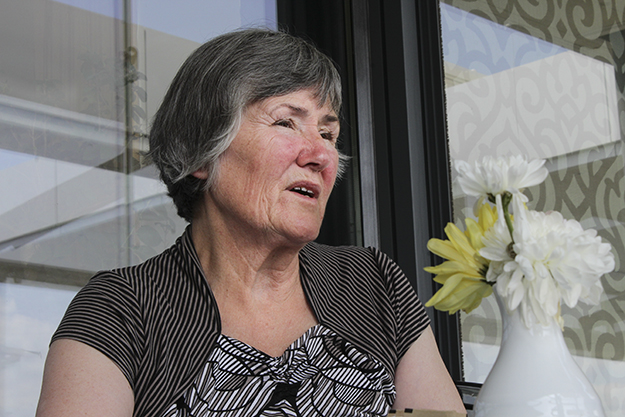It is a sunny but rainy Sunday in Polac, Drenica. Kumrie Veliu and her two daughters and four sons are making sure that the flowers that surround the grave that they are cleaning stay upright and facing the sky. The cigarettes that her husband, Xhafer, light one after the other, and the deep groans that he lets out from time to time, seem to erode his chest with every breath he takes.
“Wipe the water off of his face,” Xhafer says to Kumrie.
For Xhafer, anything that touches his son Shyqri’s cheeks is too much. Although in this case they are just raindrops that drip down his 13-year-old son’s engraved face on the marble plaque that stands above his grave.
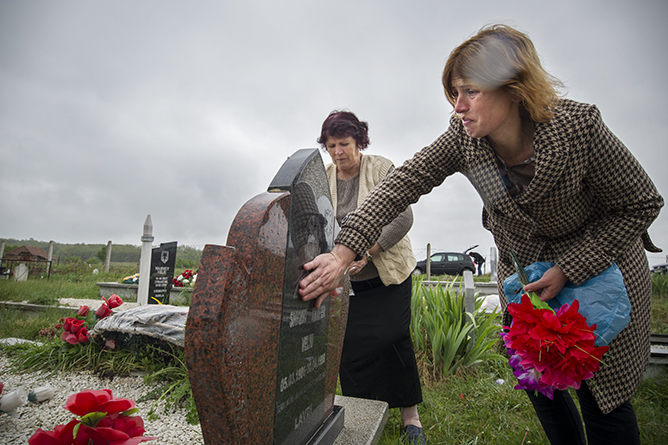
The Veliu family, regularly attend the grave of 13-year-old Shyqri, who was one of 35 children that were rounded up by Serbian forces at Qirez mosque in April 1999. Photo: Atdhe Mulla / K2.0.
“I always thought I’d find him alive,” says Shyqri’s 62-year-old father, who looks older due to fatigue, wrinkles and the wounds he suffered in 1999; he has had three such wounds on his body ever since the most recent war in Kosovo — two on his chest and one on his leg.
Eighteen years ago, on April 30, 1999, Xhafer and his son Shyqri went out of their house in Polac early in the morning, never to return together again. Xhafer recalls that day clearly even today, despite his age and poor health.
The offensive in Drenica began in March, 1999. On April 30, Polac, Verbovc, Prolluzhe, Qirez, Likoshan, Llamare, Rezalle and many other villages were almost completely surrounded by Serbian military and paramilitary forces.
“There were about 12,000 troops,” Xhafer recalls. “Over 10,000 people were sheltered in these villages at that time.”
Like many men and young boys that seeked to escape from the Serbian army, Xhafer and Shyqri headed toward the nearest mountain.
“I should never have let him go,” Kumrie says, through tears of regret that she did not manage to stop her son from joining his father on that journey toward the mountain.

Kumrie Veliu has never forgiven herself for allowing her son Shyqri to go with his father on the road to the mountain the day he was captured. Photo: Atdhe Mulla / K2.0.
However, Shyqri did not lose his life in the mountains. The village of Qirez was the last place in which Xhafer saw his son. It was here that the Serbian military and paramilitary forces rounded up around 200 people, mainly men and boys from the surrounding villages.
Xhafer recalls how his neighbor Agim Prokshi was beaten to death on the way to Qirez, leaving behind his 13-year-old nephew, Betim, who was a friend of Shyqri’s. “He was left with me and Shyqri,” Xhafer says.
Xhafer and Shyqri were separated at the Qirez mosque, the ruins of which exist to this day, despite the fact that it was bombarded by the Serbian army.
By the Qirez mosque, he points to the location in which they were kept hostage that night. The next day, the men were separated from the children, sent with trucks in unknown directions, soon to be shot to death.
Xhafer says that it was there that he first heard the name of the commander that ordered that whole operation in the Drenica zone. “‘Komando gjeneralno Ljubisa Dikovic,’ I clearly heard when they said that it was under his command,” he says.

Hundreds of Kosovars, including Xhafer Veliu and his son Shyqri were rounded up at the Qirez mosque, before being sent in different directions to be killed. Photo: Atdhe Mulla / K2.0.
Xhafer and 31 others were sent to a place called ‘Shavarina’ in the Cikatove e Vjeter village in Drenica. It took the Serbian soldiers 20 minutes to shoot dead all the men. All that is, except him and Bajram Shabani, who escaped into the mountains, despite being wounded by the bullets that were shot at them.
Xhafer has written down all these recollections, and he is thinking about publishing these writings in the future. “They are evidence and someone must deal with them,” says the man who to this day seeks justice for his murdered son.
Shyqri’s body was found in 2005, in a mass grave at ‘Shavarina’ — the same place that Xhafer had escaped death. “The least we could do is not forget him,” Xhafer says.
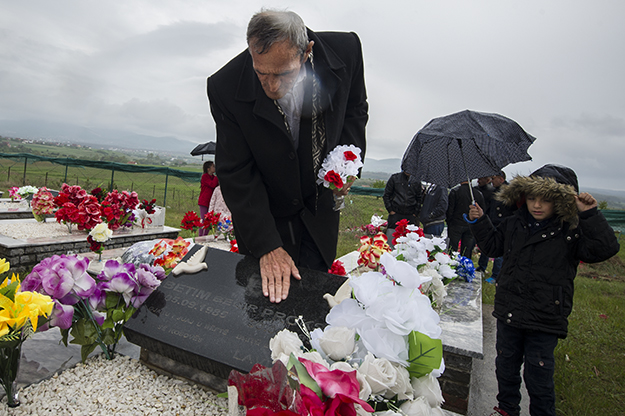
Betim Prokshi, a close friend of Shyqri Veliu’s, was another 13-year-old boy whose lifeless body was exhumed from a mass grave. Photo: Atdhe Mulla / K2.0.
However, he did not find peace even after finding his son’s remains, which he had sought for so long in mass graves. “We have been unable to find justice as of yet,” Xhafer says, letting out another light groan. He calls the Serbian army of the time “an army of horror.”
The general of the ‘army of horror’
For years now, justice for the victims of the recent war in Kosovo has also been sought by one of the most active organizations in Serbia and Kosovo, the Humanitarian Law Center (HLC). It was established by human rights activist Natasa Kandic in Belgrade, with its Prishtina office led by Bekim Blakaj.
In 2012 this Center published a document titled “The Ljubisa Dikovic Dossier.” HLC documented the crimes that were committed when the 37th Motorized Brigade was positioned in Drenica, and it holds general Dikovic responsible; it directly accuses Dikovic of not preventing heavy war crimes against civilians in Kosovo during the 1998-99 war.
Dikovic rejected these accusations in the media, calling them attacks against the Serbian army. He also sued Natasa Kandic for damaging his reputation in March 2012.
In January 2015 HLC released another report on the mass grave in Rudnica, close to Rashka in Serbia that had been discovered in 2014 near the barracks of the 37th Motorized Brigade of the Serbian army, which was led by General Ljubisa Dikovic. In this report, Dikovic and his brigade are held responsible for transporting the bodies of hundreds of civilians that were murdered in the region of Drenica; 57 of those bodies were found in Rudnica, including some of those executed at Cikatove e Vjeter that had been transported in trucks.
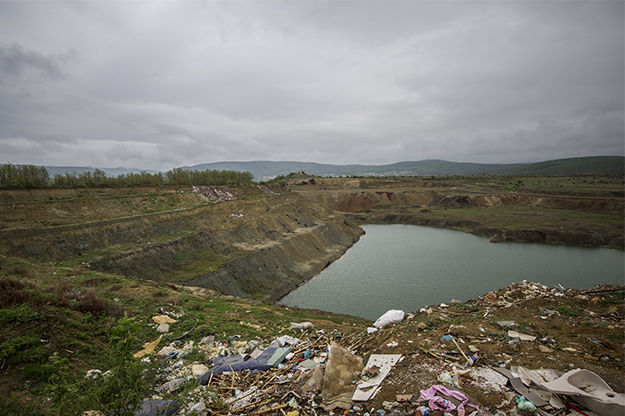
Thirty civilians were shot by soldiers operating under the command of General Ljubisa Dikovic at the place called ‘Shavarina,’ in Drenica’s Cikatove e Vjeter village. Photo: Atdhe Mulla / K2.0.
Just a month after this publication, in February 2015, the current chief of staff of the Serbian Army, General Ljubisa Dikovic, accepted the honor of becoming a “National Hero,” following the decision of the Serbian president of the time, Tomislav Nikolic. This is the highest military order in Serbia.
During the court case with Dikovic, Natasa Kandic told media that the HLC has evidence that support the claims that Dikovic was involved in war crimes.
In May 2015 she declared that: “The dossier [on Dikovic] is based on conversations with Yugoslav Army officers that were part of the 37th Motorised Brigade [commanded by Dikovic], as well as on statements from those who survived and statements from family members of the ones who were killed during the NATO bombing, when the 37th Motorised Brigade had full control of the territory of Glogovac [Drenas] and Srbica [Skenderaj, both locations where some of the alleged war crimes mentioned in the report happened].”
However, the same month, a Serbian court decided that Kandic had to pay 4,500 euros for damaging Dikovic’s reputation.
The silence of Serbian justice institutions regarding the uncovered crimes that were committed by the Serbian army caused HLC to react again a couple of years later. On February 21, 2017, HLC published a 23 minute documentary that shows the crimes committed by Ljubisa Dikovic’s 37th Motorized Brigade, through data collected by HLC during research that they had conducted while compiling the two dossiers, “Ljubisa Dikovic” and “Rudnica.”
In the published documentary it is claimed that around 1,400 civilians were killed in 1999 in the Drenica area controlled by the Serbian army’s 37th Motorized Brigade, which at the time was led by Ljubisa Dikovic, who is protected by the state from all accusations that have been made against him.

Bekim Blakaj from the Humanitarian Law Center in Kosovo believes that it is the last chance to reveal the fate of missing persons. Photo: Atdhe Mulla / K2.0.
Bekim Blakaj from HLC in Prishtina explains that up until now the justice apparatus in Serbia has not conducted any serious investigations.
“Imagine, 24 hours after publishing the dossier, the prosecution for war crimes in Serbia states that there is no evidence for investigation,” Blakaj says. “Such statements are never made anywhere in the world, without initiating investigations and conducting a legal evaluation first. But you can see in the documentary, through statements made by the former administration of [Ivica] Dacic, but also from former prime minister [Aleksandar] Vucic, that General Ljubisa Dikovic is protected by the Serbian state.”
The publication of the documentary alone had caused trouble in Serbia. HLC was forced to publish it through their YouTube channel, with officials explaining in a press conference on the publication day that certain TV channels in Serbia, including the public broadcasters Radio Television of Serbia and Radio Television of Vojvodina, had “refused or failed to respond to the request for broadcasting the documentary.”
Memorandum for war crimes
Little has been done by the Kosovar justice institutions to bring to light crimes committed by Dikovic’s brigade, but also other crimes that were committed during the war in Kosovo, including rape and torture.
In fact, the competences for investigating and dealing with war crimes were only transferred to Kosovar institutions in 2015. Up until then it was an exclusive competence of the European Union Rule of Law Mission in Kosovo (EULEX). These competences were transferred to this mission in 2008 from the United Nations Mission in Kosovo (UNMIK), which still has a few war crimes cases under its administration.
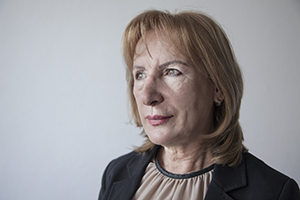
Drita Hajdari, the coordinator of the Department for War Crimes in the State Prosecutor’s Office, says that without legal cooperation with Serbia war criminals will remain unpunished. Photo: Majlinda Hoxha / K2.0.
Drita Hajdari is the coordinator of the Department for War Crimes within the Special Prosecution of Kosovo, in which there is only one other prosecutor, Elez Blakaj. Three hundred cases have been undertaken by this department since its formation, among them cases of murder, rape and massacres. Eighty-four are currently under investigation, of which 49 were handed over by EULEX in 2016. According to Hajdari, most of the cases submitted by EULEX were very close to their legal deadline for investigation.
However only two indictments for war crimes were filed by local authorities last year, and the possibility of filing new indictments seem slim as a result of a lack of cooperation between Kosovo and Serbia.
“We can file indictments against people that are in Kosovo; they are Albanian,” she told K2.0 in an interview earlier this year. “What I continuously highlight and want to highlight again is that the overwhelming majority of perpetrators are in Serbia. Both Kosovo and Serbia refuse to extradite [perpetrators]. There is no judicial cooperation.”
Some suggest that a potential solution to this blockage would be to apply the model used in Bosnia and Herzegovina, Croatia and Montenegro, with these three countries having signed memorandums of cooperation between their respective prosecutions and the Prosecution of Serbia, exclusively for war crimes.


